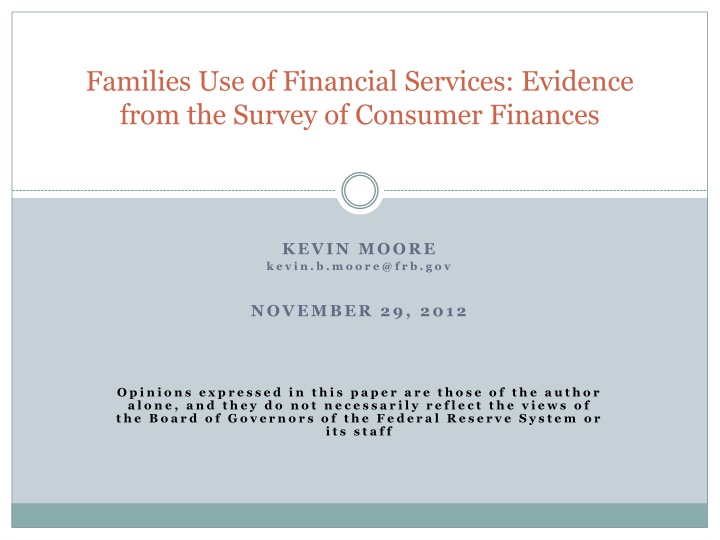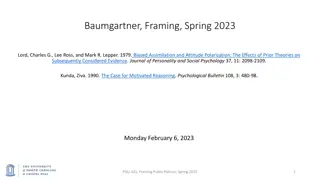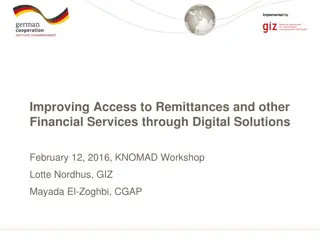Use of Financial Services: Evidence and Insights
This data presents insights on families' use of financial services, shopping behavior, demographics, and information sources for borrowing and investing based on the Survey of Consumer Finances from 2004 to 2010. It delves into shopping behavior intensity, demographic patterns, and preferred sources of financial information based on income, age, and race.
Download Presentation

Please find below an Image/Link to download the presentation.
The content on the website is provided AS IS for your information and personal use only. It may not be sold, licensed, or shared on other websites without obtaining consent from the author.If you encounter any issues during the download, it is possible that the publisher has removed the file from their server.
You are allowed to download the files provided on this website for personal or commercial use, subject to the condition that they are used lawfully. All files are the property of their respective owners.
The content on the website is provided AS IS for your information and personal use only. It may not be sold, licensed, or shared on other websites without obtaining consent from the author.
E N D
Presentation Transcript
Families Use of Financial Services: Evidence from the Survey of Consumer Finances KEVIN MOORE k e v i n . b . m o o r e @ f r b . g o v NOVEMBER 29, 2012 O p i n i o n s e x p r e s s e d i n t h i s p a p e r a r e t h o s e o f t h e a u t h o r a l o n e , a n d t h e y d o n o t n e c e s s a r i l y r e f l e c t t h e v i e w s o f t h e B o a r d o f G o v e r n o r s o f t h e F e d e r a l R e s e r v e S y s t e m o r i t s s t a f f
Shopping Behavior Intensity of Shopping when Borrowing and Investing 70 60 50 40 Percent Almost none 30 Moderate amount A great deal 20 10 0 2004 2007 2010 2004 2007 2010 Borrowing Investing Year and Type of Service
Shopping Behavior and Demographics 40-60% of households are moderate shoppers Normal income Below 40thpercentile = 30% almost no shopping Above 40thpercentile = 20% almost no shopping Wealth = similar to income Age of household head Less than 65 = 20% almost no shopping 65 or older = 35% almost no shopping Race Similar patterns for non-Hispanic whites and minorities
Information Sources Information used for decisions about borrowing or investing, 2004-2010 SCF Type of service Borrowing Investing 2004 31.6 21.2 32.5 30.0 39.3 32.6 17.2 10.2 2007 33.4 19.7 35.9 38.4 45.9 39.2 19.5 9.6 2010 27.0 14.5 28.3 41.7 43.9 39.5 19.5 14.6 2004 17.9 16.9 18.0 19.5 35.6 33.6 25.3 10.1 2007 18.0 17.5 21.5 28.3 42.3 38.3 29.3 10.2 2010 15.7 14.4 19.0 33.0 40.8 39.1 31.1 11.7 Source Calling around Magazines, newspapers, and other media Material in the mail Internet Friends, relatives, associates Bankers, brokers, and other sellers of financial services Lawyers, accountants, and other financial advisors Does not borrow or invest
Information Sources for Borrowing Everyone loves to ask friends/relatives/associates Normal income Below 80thpercentile = material in mail important until 2010 Top group = most likely to use bankers/brokers/etc. & internet Wealth Similar to income, but internet important for all groups Age of household head Less than 45 = internet is a key source 45-64 = use bankers/brokers/etc., but internet is catching up 65 or older = material in mail important, internet low on list Race Minorities = use bankers/brokers/etc. less, internet is a key source
Information Sources for Investing Everyone loves to ask friends/relatives/associates and bankers/brokers/etc. Normal income Below 80thpercentile = internet growing in importance Top group = most likely to use financial advisors Wealth - similar to income Age of household head Less than 45 = internet is a key source 45-64 = use financial planners, but internet is catching up 65 or older = internet low on list Race Minorities = use financial advisors less, internet is growing
Financial Institutions Distribution of Number of Financial Institutions 50 45 40 35 30 Percent 25 20 15 10 5 0 2004 2007 2010 Year 0 1-2 3-5 6 or more
Financial Institutions Type of financial institutions used by families, 2004-2010 SCF Year 2004 42.9 11.7 21.6 25.8 20.4 33.5 10.8 2007 47.1 10.5 22.5 26.1 22.4 32.0 11.6 2010 51.1 9.7 21.6 24.6 15.0 20.7 12.6 Type of institution Commercial bank Savings and loan Credit union Finance company Mortgage company Brokerage Other Memo: Mean number of institutions 3.3 3.4 3.2
Financial Institutions Use of financial institutions by families, 2004-2010 SCF Year 2004 61.7 76.0 58.3 74.2 48.5 47.0 9.8 32.3 2007 70.7 80.6 65.4 81.6 56.6 59.4 19.2 49.4 2010 74.8 72.8 64.4 82.0 50.3 59.3 18.8 58.5 Service ATM / Debit card Check Auto withdrawal/deposit In person Mail Phone Electronic transfer Internet
The Internet Internet Usage and Family Finances 80 70 60 50 Percent 40 30 20 10 0 2004 2007 2010 Year Borrowing Investing Institution Any
The Internet Internet Use by Wealth Internet Use by Income 90 100 90 80 80 70 70 60 60 Percent Percent 50 50 40 40 30 30 20 20 10 10 0 0 2004 2007 2010 2004 2007 2010 Year 40-79.9 Year 0-39.9 40-79.9 80-100 0-39.9 80-100
The Internet Internet Use by Age Internet Use by Race 90 80 80 70 70 60 60 50 Percent Percent 50 40 40 30 30 20 20 10 10 0 0 2004 2007 2010 2004 2007 2010 Year 45-64 Year Less than 45 65 or older White non-Hispanic Nonwhite or Hispanic
Conclusions Borrowing and investing decisions Most families are moderate shoppers Friends/relatives/associates are a key source of information The internet is becoming a key source of information Financial institutions Most families use 1 to 5 institutions In person, by ATM, by check are main ways families use institutions Internet use is on the rise Use of internet for financial actions is increasing Availability and quality of information Security issues
Public data and tools SCF Public Website www.federalreserve.gov/econresdata/scf/scfindex.htm Summary results Federal Reserve Bulletin articles Expanded tables and SCF chartbook Documentation Technical codebook Questionnaire outline Survey data Full public data set Extract data set Replicate weight files
SDA Tool SDA SCF website sda.berkeley.edu/cgi-bin36/hsda?harcscfcomb+scfcomb Contains combined extract data from 1989-2010 About 300 recoded variables Demographics Assets Debt Debt ratios Shopping patterns Attitudinal Income Capital gains Net worth























